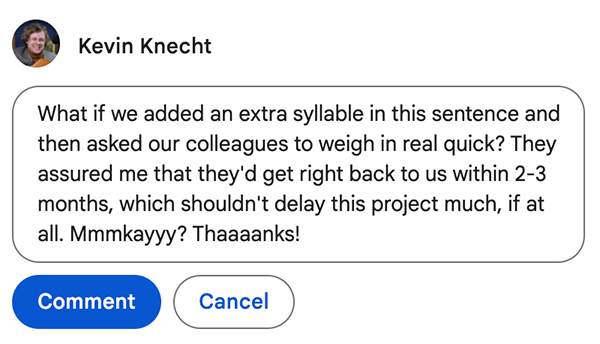The Illusion of Complete

In higher education, certainty is a hard resource to come by. Our enrollments fluctuate. And so do our budgets. Our leadership model typically encourages rotating administrative leaders (e.g., provosts, deans, and chairs). So, they change. And decision-making tends to be distributed. So, in addition to responding to our environments and competitors, we’re also responding to internal cues from neighboring departments.
But certainty gives us a sense of order and peace. With certainty, we can reasonably predict what’s coming next and where we need to be to take advantage of the upcoming opportunities.
Enter web content.
One thing that tends to be a struggle for content creators in higher education is knowing when their work is finished. That’s because web content is dynamic and, therefore, never really done. It can be adjusted throughout the course of its lifespan - added to and edited down - depending on audience needs, departmental expectations, and new data streaming in. But, in higher education, where certainty is seen as advantageous, higher education content feels like something that can be easily leashed and controlled.

But we’re not actually achieving certainty. We’re creating an illusion. We can force a set of arbitrary standards to create the sense of “done,” but it comes at a cost. Creating that sense of control means sacrificing our impact.
Focusing on control strategies is time-consuming while providing very little value in return. Control strategies are often completely disconnected from the user journey. And control strategies snuff out creativity and authenticity.
Let me give you some examples of control strategies so you can see what I am talking about.
Inflexible program page templates #
Have you ever filled out an elaborate content template? For your child psychology degree program, you need three stats for quantitative proof, two quotes from current students for social proof, a list of student resources, a section on facilities, current jobs occupied by your program’s alumni, faculty accomplishments, news stories, FAQs, and on and on and on.
Have you ever hesitated moving forward because your three stats are rather lackluster, or you can only find two? Did you have no place to describe the study abroad experiences your program hosts or your unique centers that supply incoming undergraduates with early research experience?

I am not discouraging you from using program templates or templates of any kind. It’s just that I find they tend to hamstring our content creators and weigh down our pages with sections created for the template instead of for our audience. And, sometimes, we can’t include our standout features and benefits because they don’t fit into the layout.
Program page templates often give us a sense that program page content is complete. They give us a sense of accomplishment because we’ve checked all the boxes like a long to-do list. But, if your program page templates require content that’s not worthy of prospective student attention or that doesn’t quite highlight the best your program has to offer, you’re trading in your best outcomes for a temporary feeling of certainty.
I always recommend a minimum viable program page (the top things each program absolutely needs) and then several opportunities for unique content that sells the program against its competitors.
Over-emphasis on consistency #
Consistency is important as far as usability goes. Consistent styling can convey subtle patterns of information, making the user journey easy to anticipate. But enforcing consistency can also get out of hand.

Allow me to use a metaphor. Did you have a high school English teacher who prescribed grammar rules that felt arbitrary? I did. Her name was Mrs. Walsh, and while I could charm my fair share of high school teachers, my idiosyncratic and clever responses in class and my lackluster commitment to homework seemed to thoroughly annoy her.
She had a list of 20 unbreakable grammar rules, some of which I find enormously helpful. Faulty pronoun references can always be attended to. Subject-verb agreement in complex sentence structure? Yes! Get to it. But she had others like:
- Don’t split infinitives
- “Not only” must always be followed by “but also”
- Don’t start sentences with conjunctions (and, but, or)
To follow these rules, you have to be willing to discard clarity. We write and read in the cadence in which we speak. Sometimes a “but also” ruins our rhythm. Conjunctions show us how ideas relate to one another. Cutting conjunctions from the beginning of sentences means forcing sentences to be long and overly complex or short and disconnected from one another. And don’t get me started on infinitives.
The same goes for your website’s consistency. Rules are helpful as long as they support your purpose - to increase clarity and understanding. The moment a rule gets in the way of supporting clarity, you have a great case for an exception.
Now, unfortunately, this means we have to use good judgment regarding what’s most clear and what supports our goals, and this can drive our style friends absolutely bananas. But the fact of the matter is that our prospective audiences are not out to judge us on our ability to follow our own rules. They need easy, comprehensible content relevant to them laid out in a way that’s not overly taxing on their cognition.
Stuffy and roundabout review processes #
Another way we tend to check the boxes is through tedious review processes. First, we’ll have the program area coordinator read the draft. Then, we’ll send it to the other faculty in the program. Then maybe the chair. Advisors get involved. Before you know it, you’re getting Google Docs comments from your neighbor’s second cousin twice removed for a few descriptive paragraphs on what kinds of jobs you can get with a degree in Sociology and Anthropology.
I once worked on a communications team where it took 48 hours and several directors and vice chancellors to decide on the verb tense of the subject line in an email.

Lengthy and laborious approval chains cause significant problems. Not only does getting approval to post give a false impression that the content process is complete, but it also discourages future changes because it means the whole process will have to start over again. It makes the content creator feel disempowered, it waters down the message from its original form, and it gums up the production for days or weeks at a time.
What the illusion of complete costs us #
Our content isn’t complete because it checks all the boxes, has been reviewed several times by all the right people, or because it follows all the content and style rules. First, the goal is to get the content right for our audiences. And in this case, the map is not the same as the territory. Checked boxes can’t substitute for satisfied prospective audiences. Second, it’s never complete. Ever. It’s in a dynamic environment which means it has to change from year to year or as new information comes in.
The best we can shoot for is satisfied for the time being. The trouble is that the kinds of things that get in the way of our feeling satisfied for the time being are excessive review processes, over-adherence to rules, and inflexible templates. They also get in the way of good web experiences. Completeness benchmarks slow us down and make us reluctant to test and change things.
If you want to take your content game up a notch, don’t allow the illusion of complete to interfere with your best and most timely efforts.